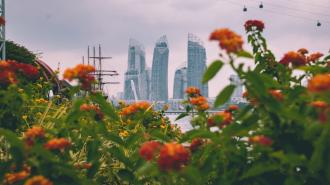Our roadways are essential to economies and our daily lives — but they also represent a major challenge to our health and the environment.
In 2021, road transport contributed the lion’s share of global transportation carbon emissions: 5.86 gigatonnes, or roughly 80% of transport-derived emissions.
Not only are our roadways a major contributor to climate change, but they also represent a material threat to the health and well-being of those living near them.
Research indicates that traffic-related air pollution is a significant contributor to asthma in children, and causes an overall decrease in lung function.
Doing away with our roadways is simply not an option — but introducing nature-based solutions can reduce the harm they cause, and make our towns and cities better places to live in the process.
Reviving and preserving biodiversity
In the British county of Cornwall, authorities are taking notice of the importance of biodiversity in the fight against climate change. Here, a 28-mile stretch of road is being turned from a polluting eyesore to a diverse ecosystem of native species.
With a government grant and in partnership with the Cornwall Wildlife Trust, National Highways has committed to restoring and recreating 16.8 hectares of woodland, orchard, grassland and heathland around one of Cornwall’s largest roads.
This project will provide 33 wildlife crossing points for local species, such as otters, bats badgers and reptiles, and restore wetlands and ponds — both effective carbon sinks — which are essential for a diverse and thriving ecosystem.
Beyond the benefits for local species and the climate, the project also aims to preserve human cultural heritage and the visual landscape of the area. Nature-based solutions like this consistently improve the health and happiness of those who live in the area — and they’re also cheaper than many man-made solutions.
Nature and improved ‘life satisfaction’ in cities
In Curridabat, a municipality home to nearly 75,000 people located on the east side of Costa Rica’s Metropolitan Area, local authorities have partnered with civil society actors and local inhabitants to rethink the urban growth patterns and redesign their parks, roads and neighborhoods, and to redefine what it means to be a citizen. Their work is guided by two main key metrics: Life satisfaction and contact with nature.
The project, dubbed Sweet City Curridabat, has received international recognition, and has been developed and founded by the citizens through their commitment and taxes. It has also attracted funding from the UN Development Programme, as well as US and European cooperation programmes. Sweet City Curridabat has given citizenship to pollinators, trees, water and soil, redefining who is a citizen and thus how they are treated. The city has switched from an anthropocentric planning scheme to a biophilic and ecocentric paradigm. Current and former City Mayors have a special focus on public policies for pollinators like bees, bats and hummingbirds; creatures essential for the continued functioning of a self-renewing natural ecosystem.
With the metric of life satisfaction in mind, authorities treat green spaces and their ecosystems like infrastructure to be managed, to increase contact with nature. They plant local and adapted species across Curridabat and install bio-corridors, many of which trace the routes of existing roads while providing natural cover and space for all the city’s citizens — human or not — to traverse.
The goal is a cooler, greener and more natural network of roads, parks, private gardens and public paths across Curridabat and an effective bio connection with the Metropolitan Area of Costa Rica, linking the city’s green spaces with regional bio corridors. Sweet City Curridabat confers both physical and mental health benefits to everyone in Curridabat, easing the area’s path to lower emissions and diminishing reliance on motor vehicles and giving space for nature’s regeneration within the urban environment.
The “cap and cover” movement
Sometimes, a more radical approach is needed. Take the ‘cap and cover’ movement, for example.
In Atlanta, Georgia, plans by the City of Atlanta are moving ahead to ‘cover’ the Downtown Connector, one of the city’s largest roadways, and install a 14-acre, three-quarter-mile green space ‘cap’ on top. The project, put simply, aims to cover one of Atlanta’s busiest roads with a park, and filter the emissions coming from beneath.
In the Bronx borough of New York City — which has the highest rate of paediatric asthma in the US — authorities are examining whether a similar cap could cover 2.5km of the 6.5km Cross Bronx Expressway, which carries 200,000 people every day through dense residential neighbourhoods.
These ambitious plans come with a hefty price tag — the Atlanta project is expected to cost $1.2 billion. But they also promise a transformative impact by covering a large road with a park.
By introducing trees into downtown Atlanta, the project would reduce the urban heat island effect and cool the city, assist the goal of 10 acres of green space per 1,000 residents, improve the mental and physical health of those in the area and contribute to a vast amount of economic activity in the newly livable area.
These projects could also undo decades of racialised segregation and division of communities. Racial and class divisions between neighbourhoods, cemented by the physical barrier of a major roadway, could start to be addressed by bridging areas that, despite their proximity, have been divided for decades.
Climate adaptation and city roadways
In some areas, the impacts of climate change are already unmistakable — and officials are leveraging decisive adaptation solutions.
In California’s Pico Rivera, responding to years of drought, the local government is initiating a large-scale overhaul of the local habitat and infrastructure. The city is replacing dead or dying shrubs and trees with drought-tolerant plants and improving its irrigation system to bolster water security.
The introduction of hardy trees and shrubbery means the city’s urban heat island effect is lessened even during times of intense heat, and improved irrigation means much-needed water goes further. Much of this work is taking place around roadways, where trees are being introduced en-masse to enable cycling and walking.
This kind of adaptation cools streets with shade and greenery, providing more options for people to walk in their daily lives. It takes cars off the street and encourages exercise — all of which improves health and cuts emissions, and relies on nature to do the heavy lifting.
What’s next for nature-based solutions and roadways?
Whether it’s covering a loud and polluting highway with a park, or granting every bee citizenship, cities are recognising that nature-based solutions can be powerful tools available for tackling climate change and improving citizens’ well-being.
Over the last year, the Global New Mobility Coalition has been collaborating with a number of public, private and civil society groups — including the City of Curridabat — to deliver the Urban Mobility Scorecard Tool. The Tool provides a benchmarking assessment for cities to assess their progress towards sustainable, inclusive mobility.
Creating people-friendly spaces in cities, such as Curridabat’s embrace of nature-based solutions, is a feature of the Tool, with a range of questions on how cities are approaching issues such as space allocation, innovation, and wider planning issues to support cities that prioritise movement by sustainable modes. Through approaches such as the Urban Mobility Scorecard Tool, cities can identify actions to advance sustainable mobility, and connect with the private sector and civil society to develop more sustainable cities.
Nature-based solutions also, critically, upend a long-standing orthodoxy: that the solution to climate change will be human-driven. In fact, only by embracing nature and nature-based solutions will we overcome this great challenge of our time.
This article was reprinted with permission of the World Economic Forum, where it was originally published.






